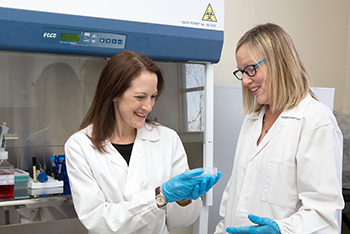
Prof Felicity Burt (right) and Dr Dominique Goedhals
from the Department of Medical Microbiology and
Virology at the University of the Free State.
Photo: Anja Aucamp
The newly established virology section at the University of the Free State (UFS) boasts world class expertise. Not only are they one of just five laboratories in the country tasked with specialised HIV testing, but current research generates publications and subsidised funding.
The driving force behind this initiative is passionate and dedicated people who invest long hours into vital research. One such person is Prof Felicity Burt, who eloquently guides her students while making impressive progress within her own field of interest: vector-borne and zoonotic diseases. Prof Burt was recently awarded a research chair (2016-2020) to, among other areas, investigate medically significant vector-borne and zoonotic viruses currently circulating.
That means that her research focus is mainly on viruses transmitted by mosquitoes and ticks, and viruses transmitted from animals to humans. “Yes,” she laughs, “I catch mosquitoes and check them for viruses.”
Becoming familiar with different viruses
As if big screen moments like Outbreak and Contagion did not create enough virus paranoia, the world was recently bombarded by real world Ebola and Zika outbreaks. But awareness, Prof Burt says, is not a bad thing. “Years ago, when people heard that I did Ebola research, they got that distant look in their eyes, and changed the subject. One outbreak later, backed by many media reports, and Ebola is almost a household name. The same goes for the recent Zika virus outbreak in South America.”
The more familiar people become with these types of viruses, the better, Prof Burt feels. However, getting the right message across is not always that easy. The Zika virus outbreak, for example, was a very large outbreak and therefore presented large numbers of affected people. Generally, not everyone infected with an arbovirus will necessarily present with symptoms. But because vector-borne viruses can spread to new areas, surveillance and awareness is important. Here in Bloemfontein, Prof Burt and her team are establishing surveillance programmes.
Gaining knowledge and preventative measures
So, next time you get all wound up about a “biological disaster”, rest assured that competent people like Prof Burt and her colleagues continuously scan the environment to gain knowledge and develop preventive measures should any risks be looming. For example, developing next-generation vaccines that are very effective, but without risk – since they are not built on the virus itself, but only on the part of the virus that will induce an immune response.
Currently, Prof Burt is also looking into the relationship between the Sindbis virus and arthritis. It is clear that we can expect many exciting findings from the UFS’s new virology unit.